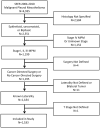Impact of mesothelioma histologic subtype on outcomes in the Surveillance, Epidemiology, and End Results database
- PMID: 25791825
- PMCID: PMC4430361
- DOI: 10.1016/j.jss.2015.01.043
Impact of mesothelioma histologic subtype on outcomes in the Surveillance, Epidemiology, and End Results database
Abstract
Background: This study was conducted to determine how malignant pleural mesothelioma (MPM) histology was associated with the use of surgery and survival.
Methods: Overall survival of patients with stage I-III epithelioid, sarcomatoid, and biphasic MPM in the Surveillance, Epidemiology, and End Results database from 2004-2010 was evaluated using multivariate Cox proportional hazards models.
Results: Of 1183 patients who met inclusion criteria, histologic subtype was epithelioid in 811 patients (69%), biphasic in 148 patients (12%), and sarcomatoid in 224 patients (19%). Median survival was 14 mo in the epithelioid group, 10 mo in the biphasic group, and 4 mo in the sarcomatoid group (P < 0.01). Cancer-directed surgery was used more often in patients with epithelioid (37%, 299/811) and biphasic (44%, 65/148) histologies as compared with patients with sarcomatoid histology (26%, 58/224; P < 0.01). Among patients who underwent surgery, median survival was 19 mo in the epithelioid group, 12 mo in the biphasic group, and 4 mo in the sarcomatoid group (P < 0.01). In multivariate analysis, surgery was associated with improved survival in the epithelioid group (hazard ratio [HR] 0.72; P < 0.01) but not in biphasic (HR 0.73; P = 0.19) or sarcomatoid (HR 0.79; P = 0.18) groups.
Conclusions: Cancer-directed surgery is associated with significantly improved survival for MPM patients with epithelioid histology, but patients with sarcomatoid and biphasic histologies have poor prognoses that may not be favored by operative treatment. The specific histology should be identified before treatment, so that surgery can be offered to patients with epithelioid histology, as these patients are most likely to benefit.
Keywords: Biphasic; Epithelioid; Fibrous; Mesothelioma; SEER; Sarcomatoid; Surgery.
Copyright © 2015 Elsevier Inc. All rights reserved.
Figures




References
-
- Ettinger DS, Akerley W, Borghaei H, et al. Malignant pleural mesothelioma. J Natl Compr Canc Netw. 2012;10:26. - PubMed
-
- Balduyck B, Trousse D, Nakas A, et al. Therapeutic surgery for nonepithelioid malignant pleural mesothelioma: is it really worthwhile? Ann Thorac Surg. 2010;89:907. - PubMed
-
- Bovolato P, Casadio C, Bille A, et al. Does surgery improve survival of patients with malignant pleural mesothelioma? A multicenter retrospective analysis of 1365 consecutive patients. J Thorac Oncol. 2014;9:390. - PubMed
-
- Curran D, Sahmoud T, Therasse P, et al. Prognostic factors in patients with pleural mesothelioma: the European Organization for Research and Treatment of Cancer experience. J Clin Oncol. 1998;16:145. - PubMed
-
- Flores RM, Zakowski M, Venkatraman E, et al. Prognostic factors in the treatment of malignant pleural mesothelioma at a large tertiary referral center. J Thorac Oncol. 2007;2:957. - PubMed
Publication types
MeSH terms
Grants and funding
LinkOut - more resources
Full Text Sources
Other Literature Sources
Medical
Miscellaneous

